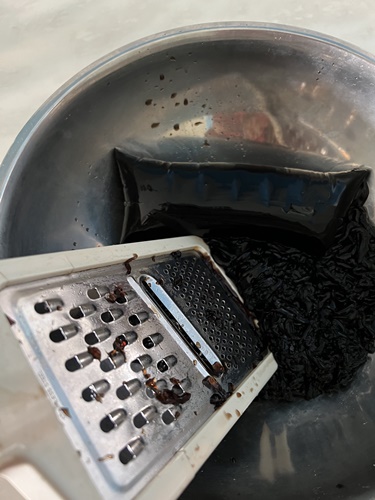As I’ve said before, I love gado gado, my family loves gado gado (except for my son because he doesn’t like peanut sauce), my Indonesian friends also love this dish, so this is what I usually make when we have gatherings at home. I’ve posted gado gado recipe before, but this one is different.
Gado gado or Indonesian traditional salad is a dish that is full of fresh or boiled vegetables than can be eaten with rice, lontong (rice cake cooked in banana leaves), or as it is. We usually add boiled eggs, keropok, and lots of fried shallots. The dish is served with homemade peanut sauce or dressing. We can either use a grinder or blender, or food processor, but the best one is still the one that is made using mortar and pestle (although I’m not gonna do that especially if I make this for many people).
For better taste of the sauce, I always combine peanuts and cashew nuts as many us do in my home country. Can we use peanut butter? I don’t recommend because peanut butter is usually sweet because sugar was added, but for gado gado sauce. we always use coconut or Javanese red sugar instead of white sugar. So the taste will be different.
What differentiate the sauce from my previous recipe is the using of coconut milk and the sauce is cooked with more spices added when making the sauce. This is East Java sauce version while my previous one is Jakarta/Betawi version. I found both were really good and I love both versions.
For the sauce, you can blend until smooth, but I like to still bite the peanuts when tasting the sauce, so I didn’t blend it until really smooth, but that will depends on your preference.
Ingredients:
For The Sauce:
- 300 gr roasted or air fried peanuts (no salt added)
- 200 gr roasted or air fried cashew nuts (no salt added)
- 100 gr coconut sugar or Javanese red sugar (in blocks), grated
- 5 kaffir lime leaves
- 3 thumbs kencur
- 1.5 tsp ground coriander seeds
- 1.5 tbsp salt, or to taste
- 200 ml canned coconut milk
- 1 L of water
- 3 tbsp cooking oil
- 10 shallots
- 6 garlic
- red chili, as much as you want
- Lime juice from 1 large lime
Vegetables (of your choice):
- potatoes
- long beans
- mung bean sprouts
- cucumbers
- tomatoes
- fried white firm tofu
- lettuce
Other:
- boiled eggs
- keropok (rice crackers)
- belinjo crackers
- fried shallots
Method:
- Heat a wok with cooking oil and fry shallots, garlic, and red chili until they are soften. Transfer to a the bowl of a blender or food processor or grinder. do not remove the oil
- To the bowl, add peanuts, cashew nuts, coconut sugar, lime leaves, kencur, coriander seeds, and some of the water. Blend until you reach the consistency that you want (you can blend until smooth or still with chunky peanuts texture). Transfer the mixture back to the wok
- To the wok, add coconut milk, the remaining water, and salt. Cook until it boils, then adjust the taste (add extra salt if necessary). Continue cooking until it thickens. Remove from heat and squeeze some lime juice. Stir to mix
- Let it cool completely before serving and storing
- Store the leftover in an airtight container in the fridge
- Arrange the vegetables of your choice and boiled eggs in serving plates, pour the peanut sauce, then top with keropok (crackers) and sprinkles fried shallots




































